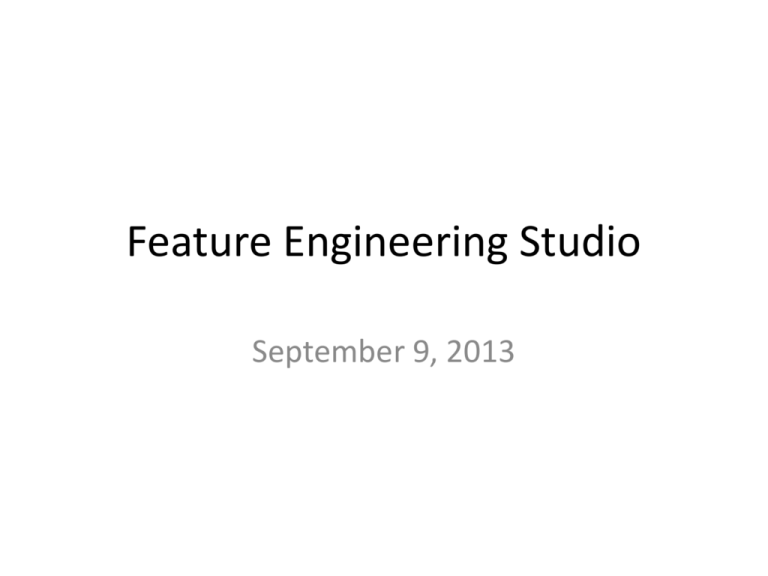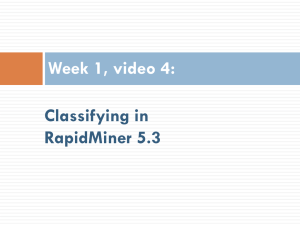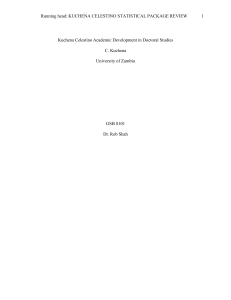pptx
advertisement

Feature Engineering Studio September 9, 2013 Welcome to Feature Engineering Studio • Design studio-style course teaching how to distill and engineer features for data mining What We’ll Cover • The process of feature engineering and distillation – brainstorming features – deciding what features to create – criteria for selecting features – actually creating the features – studying the impact of features on model goodness Why? • Feature engineering is the most important, and least well-studied part of the process of developing prediction models • It is an art, it is human-driven design • It involves lore rather than well-known and validated principles • It is hard! (But fun, and important) Why? • It’s well known in data mining (and statistics for that matter) • That your model will never be any good if your features (predictors) aren’t very good The Big Idea • How can we take the voluminous, ill-formed, and yet under-specified data that we now have in education • And shape it into a reasonable set of variables • In an efficient, effective, and predictive way? Tools We’ll Use • • • • • • Excel Java Google Refine EDM Workbench RapidMiner Other relevant tools (TBD/your choice) Course times • Monday 11am-12:40pm • Wednesday 11am-12:40pm special sessions Course Prerequisite • Core Methods in Educational Data Mining • Or instructor approval • I will approve anyone who has at least a little bit of background building prediction models or similar statistical models – Talk to me after class, during my office hours, or by appointment That said… • If you haven’t had experience building prediction models in RapidMiner or a similar tool, then you’ll need to learn • I will be using the first few Wednesday sessions to help students catch up if they don’t have experience with this paradigm or tools • You can definitely catch up Who here? • Took or audited my Core Methods course? • Has built a prediction model using a classification algorithm and cross-validation? • Has built a regression model in a stats package using stepwise regression? • Has run a regression in a stats package? • Has built any kind of mathematical model? How this class works • Lots of assignments (13) – They can’t be late, because we will discuss them in class – 3 of 12 regular assignments can be missed without penalty, but not the final presentation (13) • Not many required readings • Essential to participate in critique and class discussions Who here? • Has had a design studio style course before? This is not… • A lecture class • A reading discussion seminar This is… • A class where you will be working on a project of your own choosing the whole semester • A class where you’ll get, and give, a lot of constructive criticism • A class where we will hopefully have fun too, to keep the mind flowing The semester project • You will build a prediction model • If you have your own data set, and research question – perfect! • If you don’t have your own data set, and research question – no worries! I will help you find one! Assignments 1. 2. 3. 4. 5. 6. Problem Proposal Mucking Around Bring Me a Rock Bring Me Another Rock Standing on the Shoulders of Giants Ideation Assignments 7. One Who Visions Must Be Steeped in Data 8. Keep Running! 9. The Fresh Mind 10. This One’s For Nikolai Ivonavich Lobachevsky! 11. The Slog 12. Son of Slog 13. Final Project Presentation Upcoming Classes • 9/11 Special session on data set finding – Come to this if you don’t have a data set in mind • 9/16 Problem proposal (Asgn. 1 due) • 9/23 Feature distillation in Excel (Asgn.2 due) • 9/25 Special session on prediction models – Come to this if you don’t know why student-level crossvalidation is important, or if you don’t know what J48 is • 9/30 Advanced feature distillation in Excel (Asgn. 3 due) • 10/2 Special session on RapidMiner – Come to this if you’ve never built a classifier or regressor in RapidMiner (or a similar tool) – Statistical significance tests using linear regression don’t count… Assignment One • Problem Proposal – Due next Monday • Be ready to talk for 3 minutes on: – A data set • Give where it came from and how big it is • You need to already have this data set, or be able to acquire it in the next two weeks – – – – A prediction model you will build in this data set What variable will you predict? What kind of variables will you use to predict it? Why is this worth doing? Example (Pardos et al., 2013) • Data set – ASSISTments system, formative assessment and learning software for math used by 60k students a year (Razzaq et al., 2007) – 810,000 data points from 229 students studied – Student actions in the software have been overlaid with synchronized field codes of student affect (boredom, frustration, etc.) • 3075 field codes • Each field code connects to 20 seconds of log file actions Example (Pardos et al., 2013) • We will predict whether a student is bored at a specific time – So that we can replicate the human judgments without needing a field observer • We will predict this from what was going on in the log files at the time the field observation was made – We know every student action’s correctness, timing, relevant skill, and probability they knew the skill Example (Pardos et al., 2013) • This is worth doing because boredom is known to predict student learning (Craig et al., 2004; Rodrigo et al., 2009; Pekrun et al., 2010) • And building a detector will help us study boredom more thoroughly • As well as enabling us to intervene on boredom in real time Important Considerations • Is the problem genuinely important? (usable or publishable) • Is there a good measure of ground truth? (the variable you want to predict) • Do we have rich enough data to distill meaningful features? • Is there enough data to be able to take advantage of data mining? You don’t need to be able to answer these questions in a week • Think about them • Think about your problem • Email me or come to my office hours (or set up an appointment) • Bring it to class • We’ll discuss it in class • No idea is perfect right from the start! Be ready to answer questions Be ready to answer questions • Be ready to ask questions too… No data ready at hand? • Come to this Wednesday’s session, we will find you data!







